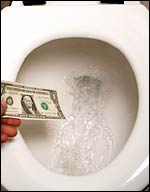Dear Umbra,
I’m selling my house in Los Angeles and my toilet is not low-flow. One of the inspectors is trying to tell me I need to replace my toilet with a new low-flow. Well, I know the old ziplock baggie filled with water trick. But I saw that you made mention of some kits to reduce the flow from 3.5 gallons per flush to 1.6 gallons a flush. I believe in recycling. I don’t feel that I have to replace my working toilet. Can I modify it? I feel like he’s just trying to make a pretty penny. Help me out with your words of wisdom.
Susan
Los Angeles, Calif.
Dearest Susan,
I’m only a little better with realty than I was with tax law. I am confounded as to how an inspector would make any money if you replaced your toilet, and am further confused by mention of multiple inspectors. Please talk to your realtor, who should be able to advise you as to your obligations.
I did mention toilet adaptation kits back in the autumn of 2005. If you look carefully at that question, however, you will see the writer was a renter. Sadly for you, if you own the house and have the cash, you should replace the toilet. New, low-flow toilets are so far superior to old high-flow toilets that replacement is the only professionally recommended option. Plus, who wants to buy a house with a toilet with a bag in it?

Of loos and lucre.
Photo: iStockphoto
It’s true, you can put a bag of water in the tank (never use a brick — they tend to disintegrate) or any of these special flappers meant to reduce the water flow into the tank, but that will not bring the flow down as efficiently or as effectively as a new model. When I wrote about the renter and her toilet adaptation, I got several letters from professionals admonishing me for even mentioning adaptation. Efficient toilets are one of those amazing easy conservation steps. The toilet could be up to 30 percent of your household water use. If you get a toilet twice as efficient — go from 3 gallons per flush to 1.6 per flush — you can do the math on how much water you conserve without changing your behavior.
That said, shopping for toilets can be a little baffling. They all look the same, except for the ones that look weird. How can you tell they’ll actually flush everything down, or whether they’ll break and cost a plumber’s visit? The EPA Water Sense program certifies High Efficiency Toilets, and all over the web you can find various lists of best toilets compiled by plumbers and agencies. If you happen to be near a decent plumbing store, where they sell and service toilets, they should also know which models work well and which need to be repaired too often.
Don’t worry about your old toilet. Dispose of it carefully and it might have a new, happy life in the great outdoors as a crushed porcelain walkway mixture. I would personally far rather be a crushed walkway than a toilet bowl.
Plungingly,
Umbra


